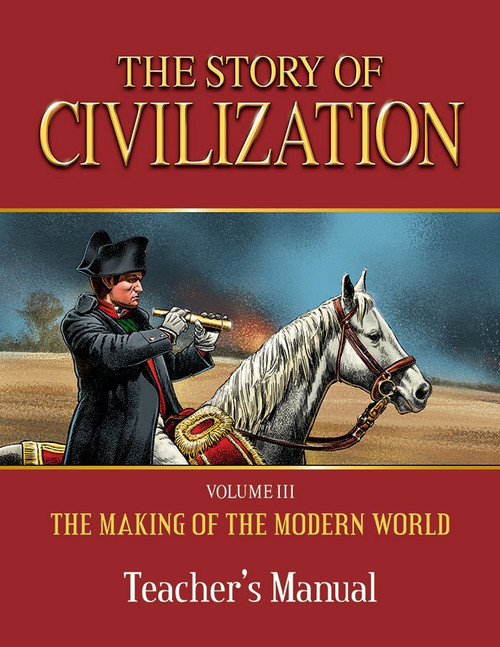Children should not just read about history; they should live it. In The Story of Civilization, the stories that have shaped humanity come alive like never before. Author Phillip Campbell uses his historical expertise and storytelling ability together in tandem to present the content in a fresh and thrilling way.
The Story of Civilization reflects a new emphasis in presenting the history of the world as a thrilling and compelling narrative. Within each chapter, children will encounter short stories that place them directly in the shoes of historical figures, both famous and ordinary, as they live through legendary battles and invasions, philosophical debates, the construction of architectural wonders, the discovery of new inventions and sciences, and the exploration of the world.
Volume III: The Making of the Modern World continues the journey, picking up where Volume II left off amidst the Renaissance and quickly diving in to the history-altering events of the Reformation. This fracturing of the Church dramatically altered the course of modern Europe and the world at large.
But during the most tumultuous times, God gives us the greatest saints. Children will meet great figures like Sts. Pius V, Thomas More, John Vianney, and Margaret Mary Alacoque, as well as powerful leaders like Napoleon and Kings Henry VIII of England and Louis XIV of France. This volume brings us through present-day Europe, showing us the effects of two world wars and how the Church responded to these changing times.
Timeline Poster
Keeping track of the people, events, and dates that shaped history can be difficult. With this fun, comprehensive, and engaging timeline that employs an easy-to-follow format and vibrant illustrations, students will have the help they need to track the chronology of the story of civilization.
This timeline mirrors the scope of The Story of Civilization text book, beginning with the colonization of the New World and running to the Cold War and fall of the Soviet Union. Within these bookends, children will be introduced to Martin Luther and the devastating fallout of the Reformation, the Catholic Church's Counter-Reformation response, Napoleon Bonaparte and the French Revolution, the prisoner popes of the late 19th and early 20th centuries, Adolf Hitler and the story of World War II, and so much more. A fun “Timeline Trivia” section can be found on the back for students to test their knowledge!
Features include:
• Laminated format capable of being written on with a sharpie
• 36 x 18 size when unfolded
• Easy-to-follow structure
• 40+ illustrations
• Covers over 75 major events and people
• “Timeline Trivia” on the back
- Author:
- Phillip Campbell
- Publication Date:
- 6/4/2018
- Product Format:
- Poster
- SKU:
- 2695
- Imprint:
- TAN Books
- Grade:
- First Grade
- Grade:
- Second Grade
- Grade:
- Third Grade
- Grade:
- Fourth Grade
- Grade:
- Fifth Grade
- Subject:
- History
1 Review
-
Disappointing - Factual Mistakes and Anti-Catholic Comments
Examples: 1553-1558: “Mary Tudor … has violent conflicts with English Protestants.” -- On the contrary, there was much rejoicing in England at Queen Mary’s accession and a peaceful, happy return to the Faith by most of her subjects. c.1570-1600: “English Catholics are forced to have secret Masses…” -- That seems to imply that the persecution of Catholics ended around 1600. On the contrary, Catholics were persecuted with varying intensity and were not allowed by law to fully participate in public life in England until the Catholic Emancipation was enacted in 1829. 1605: “Guy Fawkes, an angry Catholic, unsuccessfully carries out the Gunpowder Plot sneaking in to put 36 barrels of gunpowder…” -- Robert Cecil couldn’t have put it better. c.1687-1716: “Leopold and Prince Eugene of Savoy drive the Turks out of Hungary at the Battle of Mohacs …” However, this Second (!) Battle at Mohacs in 1687 bears less historical significance than the most consequential Battle of Mohacs in 1526 (not mentioned in this timeline!). In 1526, the Turkish forces obliterated the Hungarian army at Mohacs. Thus, the route to the heart of Europe opened up and 150 years of plundering and devastating of Hungary began. Mentioning of the Battle of Zenta in 1697 (the most decisive engagement of the war) and the Treaty of Karlowitz signed in 1699 would have been more fitting. 1917: “The Bolsheviks, led by Vladimir Lenin, revolt and overthrow Czar Nicholas II, renaming Russia the Union of Soviet Socialist Republics (USSR) …” -- However, Czar Nicholas II abdicated on March 15, 1917 and the Russian Provisional Government took power. The Bolshevik Revolution started on November 7, 1917. Also, the Russian Soviet Socialist Republic was a part of the USSR which was made up by 15 soviet republics. These comments refer only to the timeline I purchased and I pray that the textbook does not carry the same inaccuracies and anti-Catholic biases.











